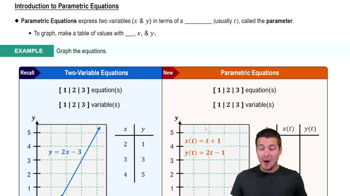Table of contents
- 0. Review of College Algebra4h 43m
- 1. Measuring Angles40m
- 2. Trigonometric Functions on Right Triangles2h 5m
- 3. Unit Circle1h 19m
- 4. Graphing Trigonometric Functions1h 19m
- 5. Inverse Trigonometric Functions and Basic Trigonometric Equations1h 41m
- 6. Trigonometric Identities and More Equations2h 34m
- 7. Non-Right Triangles1h 38m
- 8. Vectors2h 25m
- 9. Polar Equations2h 5m
- 10. Parametric Equations1h 6m
- 11. Graphing Complex Numbers1h 7m
10. Parametric Equations
Graphing Parametric Equations
Problem 8.30
Textbook Question
Graph each plane curve defined by the parametric equations for t in [0, 2π] Then find a rectangular equation for the plane curve. See Example 3.
x = 2 cos t , y = 2 sin t
 Verified step by step guidance
Verified step by step guidance1
Step 1: Recognize that the given parametric equations x = 2 \cos t and y = 2 \sin t represent a circle in the parametric form. The parameter t varies from 0 to 2\pi, which is a full rotation around the circle.
Step 2: To graph the plane curve, plot points for various values of t within the interval [0, 2\pi]. For example, calculate (x, y) for t = 0, \frac{\pi}{2}, \pi, \frac{3\pi}{2}, and 2\pi. These points will help you sketch the circle.
Step 3: Notice that the parametric equations are similar to the standard form of a circle x = r \cos t and y = r \sin t, where r is the radius. Here, r = 2, indicating a circle with radius 2 centered at the origin.
Step 4: To find the rectangular equation, use the Pythagorean identity \cos^2 t + \sin^2 t = 1. Substitute x = 2 \cos t and y = 2 \sin t into this identity to eliminate the parameter t.
Step 5: Solve for the rectangular equation by substituting: \left(\frac{x}{2}\right)^2 + \left(\frac{y}{2}\right)^2 = 1, which simplifies to x^2 + y^2 = 4. This is the equation of a circle with radius 2 centered at the origin.
 Verified video answer for a similar problem:
Verified video answer for a similar problem:This video solution was recommended by our tutors as helpful for the problem above
Video duration:
3mPlay a video:
Was this helpful?
Key Concepts
Here are the essential concepts you must grasp in order to answer the question correctly.
Parametric Equations
Parametric equations express the coordinates of points on a curve as functions of a variable, typically denoted as 't'. In this case, x and y are defined in terms of the parameter t, allowing for the representation of curves that may not be easily described by a single equation. Understanding how to manipulate and interpret these equations is crucial for graphing the curve.
Recommended video:

Parameterizing Equations
Graphing Parametric Curves
Graphing parametric curves involves plotting points defined by the parametric equations over a specified range of the parameter. For the given equations x = 2 cos t and y = 2 sin t, as t varies from 0 to 2π, the points trace out a circle. Familiarity with the unit circle and the behavior of sine and cosine functions aids in visualizing the resulting graph.
Recommended video:

Introduction to Parametric Equations
Rectangular Equation
A rectangular equation eliminates the parameter by expressing the relationship between x and y directly. For the given parametric equations, using the identities cos²(t) + sin²(t) = 1 allows us to derive the rectangular equation x² + y² = 4. This transformation is essential for understanding the geometric properties of the curve in Cartesian coordinates.
Recommended video:

Convert Equations from Rectangular to Polar

 4:47m
4:47mWatch next
Master Introduction to Parametric Equations with a bite sized video explanation from Patrick
Start learningRelated Videos
Related Practice
Textbook Question
In Exercises 71–76, eliminate the parameter and graph the plane curve represented by the parametric equations. Use arrows to show the orientation of each plane curve.x = 2t − 1, y = 1 − t; −∞ < t < ∞
529
views
